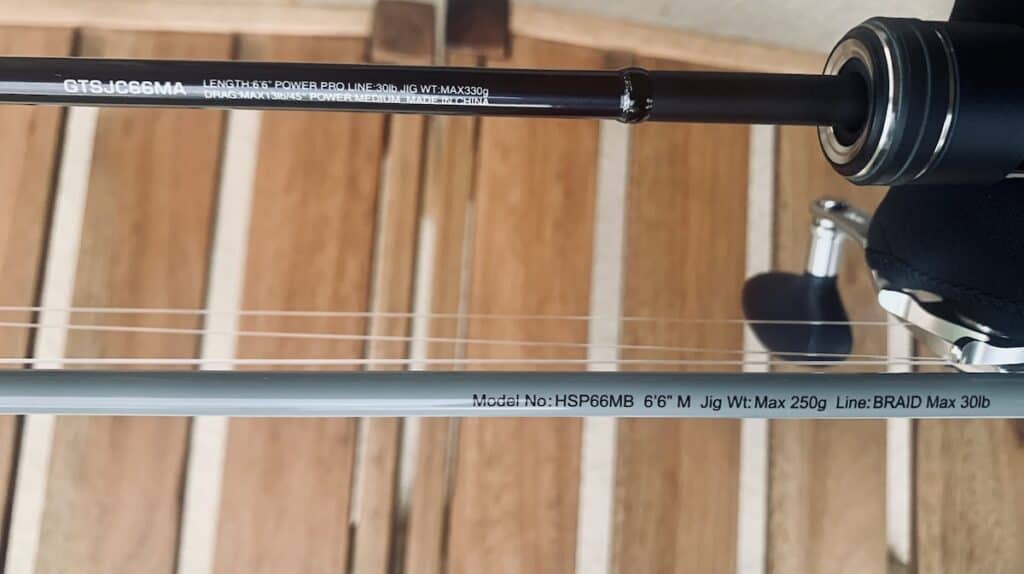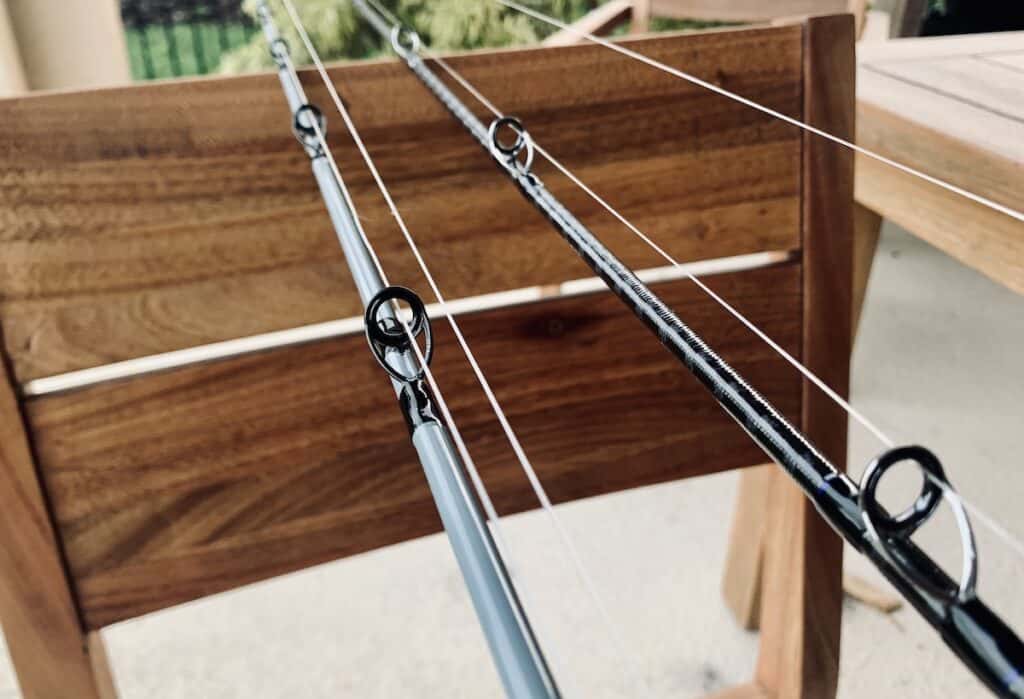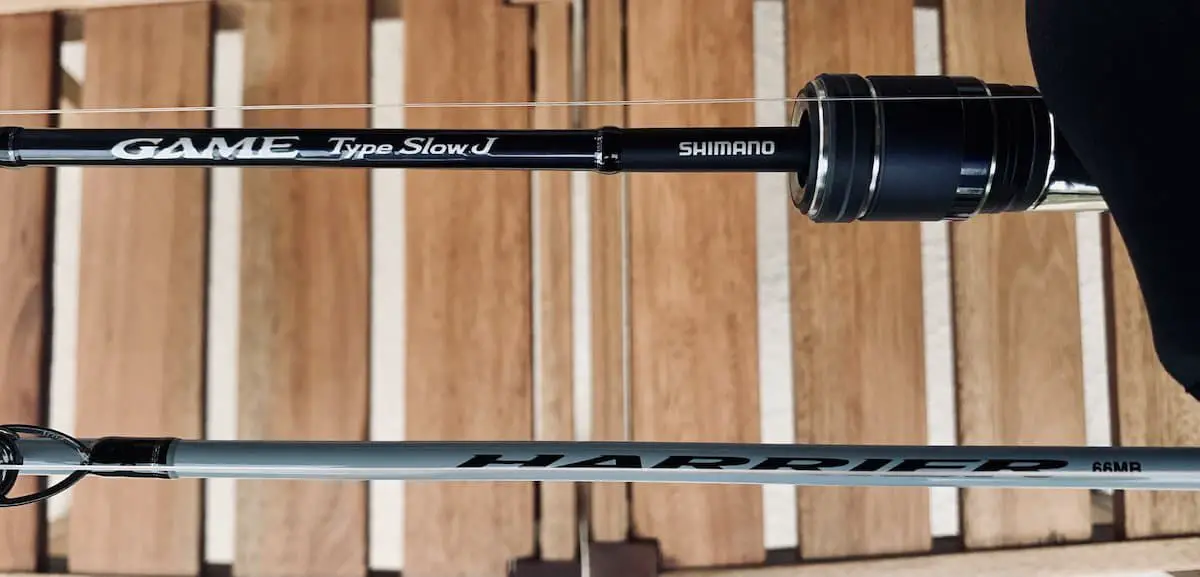The multiple types of jigging rods can make it difficult for anglers to figure out which one to buy. Speed jigging, slow pitch jigging, and butterfly jigging are all unique techniques.
High speed vertical jigging consists of letting a jig drop rapidly to the ocean floor, then retrieving it quickly up the water column while simultaneously working the rod with a twitch and pause pattern. This technique imitates a fleeing, but healthy, baitfish and causes fish to strike hard. The line strength is high and the jigs are heavy. High speed vertical jigging relies on keeping the line taut.
Slow pitch jigging is quite the opposite. The technique relies heavily on keeping slack in the line. Heavy jigs fall slowly and wobbly to the ocean floor to imitate a dying baitfish. The line strength is light and the technique is slow and rhythmic. If you’re specifically looking for a slow pitch jigging rod, my article Slow Pitch Jigging Rods: How to Choose One may be a better article for you to read through.
Butterfly jigging falls somewhere in between. The rod is worked in a vertical circular motion and the heavy jigs will often spiral or yo-yo. The jigs imitate injured baitfish and can be effective during both the fall and the retrieve.
The rod needs for high speed vertical jigging, slow pitch jigging, and butterfly jigging vary greatly. Slow pitch needs slow action and noodley rods, while speed jigging needs fast action and heavy rods. Read on to learn more details about the different rod features and how to choose a rod that aligns with your chosen technique.
Conventional for Slow Pitch, Angler's Preference for Speed and Butterfly
The choice between a conventional or spinning rod is primarily determined by the reel type.
A conventional reel is ideal for slow pitch vertical jigging. This is a slow technique in which the fisherman will hold the reel and work it slowly up and down, paying careful attention to maximizing the amount of time the jig spends in freespool. A conventional reel fits easily in a fisherman’s palm and allows the angler to vary the thumb pressure applied to the spool during freespool. The angler can slow down the freespool as much as desired. The freespool speed cannot be as easily adjusted with a spinning setup.
Butterfly jigging and high speed vertical jigging can be effectively done with both conventional or spinning tackle. When choosing a setup for these types of jigging, I recommend choosing the one you’re more comfortable with. A spinning setup is widely regarded as the easiest setup to learn. A conventional setup is more challenging as the angler must prevent a bird’s nest from happening any time the reel is in freespool.
Jigging Rods Should be as Long as Typical Boat Rods
High speed vertical jigging, slow pitch jigging, and butterfly jigging are all techniques done off the side of a boat. The rods must be long enough to provide enough distance away from the boat, without being so long that you lose control, or lose the ability to reasonably store the rod. In general, this equates to a length sweet spot between 5’9” and 7’2”.
A rod towards the shorter end of the range works well for speed jigging. It can give the angler better leverage on strong fish. A rod towards the longer end of the range works well for the parabolic rhythm of a slow pitch technique. Although this is true, speed jigging rods and butterfly jigging rods are often used for other techniques too, and anglers sometimes opt for a 7’2” rod to use for both speed jigging and bottom fishing.
Let Your Lure Rating Determine the Power
The lure rating of the rod directly affects the power level. The heavier the lure rating, the heavier the rod power. In order to choose the appropriate power for your jigging rod, you need to have an estimate of what size jigs you’ll use with it.

The good news is that estimating the right jig size for jigging is very simply. An accepted rule of thumb among recreational fishermen is 1 gram of jig weight per foot of water depth. So if you’re fishing frequently in 200 feet of water, you’ll want to make sure the rod can handle at least 200 grams of lure weight. I recommend adding some margin and getting a rod that handles 250 or 300 grams.
Depending on the rod, a lure rating of 250 grams could be Medium power, Heavy power, or anything else.
Line Rating
Each jigging rod will also have a line rating associated with it. For jigging rods, this is normally listed as braided line rating because braid is highly recommended as a main line when jigging.
The line strength when jigging varies based on technique. Slow pitch jigging requires very small line diameters to help maintain the sensitivity with a slack line. The angler needs to be able to feel the soft strike of a fish and also needs to feel when the jig makes contact with the ocean floor. Generally, 30 lb test braid is a good choice for slow pitch jigging. Experts will go even lighter when going in deep water to help reduce line scoping.
When speed jigging or butterfly jigging, the line strength will be heavier. These methods are faster and fish strike harder, necessitating heavier line strength. If you’re new to the technique, somewhere between 40-65 lb test line is a good starting point.
Fast Action for Speed Jigging, Slow Action for Slow Pitch
The best action of the rod depends on which type of jigging you’re doing. A slow action looks like a slow and long bend through the whole length of the rod. A fast action looks like just the tip is bending. The action is the part of the rod that is responsible for imparting action on the jig and also affects how quickly you get to the backbone, or fighting power, of the rod.
For slow pitch jigging, you’ll want a relatively slow action rod. This is not to be taken literally, however. A lot of times, with these lightweight and light power slow pitch rods, it doesn’t take much to get the rod to bend all the way over. It’s not uncommon to see slow pitch rods with the action listed as “moderate”. The slower action allows the rod to bend in a smooth, rhythmic manner when working the jig.
For speed jigging and butterfly jigging, the action should be faster. The jig will be twitched up, paused, and twitched again. A faster action helps the jig respond quickly to these actions. The faster action also helps get to the rod backbone faster, which is needed when speed jigging or butterfly jigging for very strong fish.
My article Top 7 Saltwater Jigging Rods includes top rods for slow pitch, speed, and butterfly jigging.
Look for Lightweight, High Torsional Rigidity Blanks
The methods of building a rod and laying the carbon fiber greatly affect the strength of the rod, especially in certain directions. Lower end rods use the simplest form of laying the carbon fiber which generally uses the most resin and has the weakest torsional strength.
High end rods will use higher density carbon fiber sheets and lay them diagonally and alternating directions. The high density carbon fiber helps manufacturers use less resin in the manufacturing process, resulting in a lighter rod. Although this is an oversimplification of the manufacturing processes, you can see how the higher end rods use better materials and technology which results in a higher strength rod at a lighter weight.
Some well-known technologies to look for are Shimano’s Spiral X, and Hi Power X. Also Daiwa’s X45 and HVF nanoplus. These technologies will decrease blank twisting and decrease the required resin.
Lightweight, Strong Guide Frames and Durable, Smooth Inserts
The rod guide quality is another highly important feature in a rod. The ideal guide for jigging, is a ring guide with a light weight and high strength frame, and a durable and frictionless insert. Some common materials for guide frames are titanium and corrosion resistant aluminum. Titanium is the top end, and usually comes on rods with a hefty price tag.

As for rod guide inserts, you’ll see ceramics, SiC (Silicon Carbide), Zirconium, and proprietary materials such as Fuji Fazlite. Durability in a rod guide insert is highly important, especially when using braided main line. Braid has the power to slice through weaker insert materials. Also, weaker materials can crack or break if the rod is accidentally dropped and I can almost guarantee that a broken guide insert will slice through your line.
Generally, you should choose the rod with the highest quality guide you can with your budget. The highest quality rod guide inserts will be the most durable, smoothest, and lightest weight. Some common materials, in rough order of lowest quality to highest quality, are Fuji Fazlite, Fuji Alconite, Zirconium, and Silicon Carbide.
Grip Style/Butt
When looking at a conventional rod, also called a casting rod, a trigger grip is best. It helps give you the most control as you’re palming the reel, thumbing the spool, and reaching around the rod. A spinning rod will not have a trigger grip because the spinning reel naturally creates one with the base of the reel.
Because slow pitch jigging needs a slow action rod, a split grip is best. The split grip helps the rod bends all the way back to the butt end of the rod. It also helps to minimize the weight of the rod. When speed jigging or butterfly jigging, this style is less important because they are faster action rods and they aren’t held for nearly as long durations as slow pitch rods.
A lightweight, high sensitivity reel seat also helps the angler realize the advantage that braided main line provides. A common one by Shimano is the Ci4+ reel seat which increases sensitivity while minimizing weight.
I’m confident this article has helped you understand a bit more about jigging rods. Now to figure out what reel to pair it with, read my article Jigging Reels. Tight lines, y’all!

